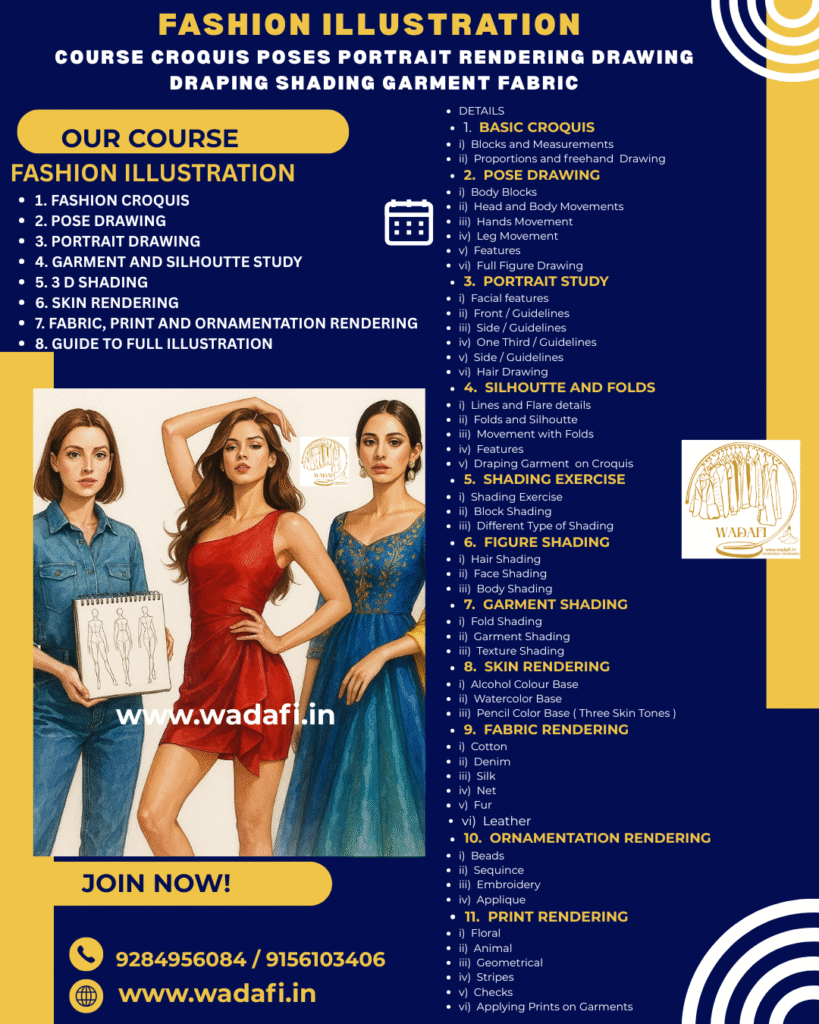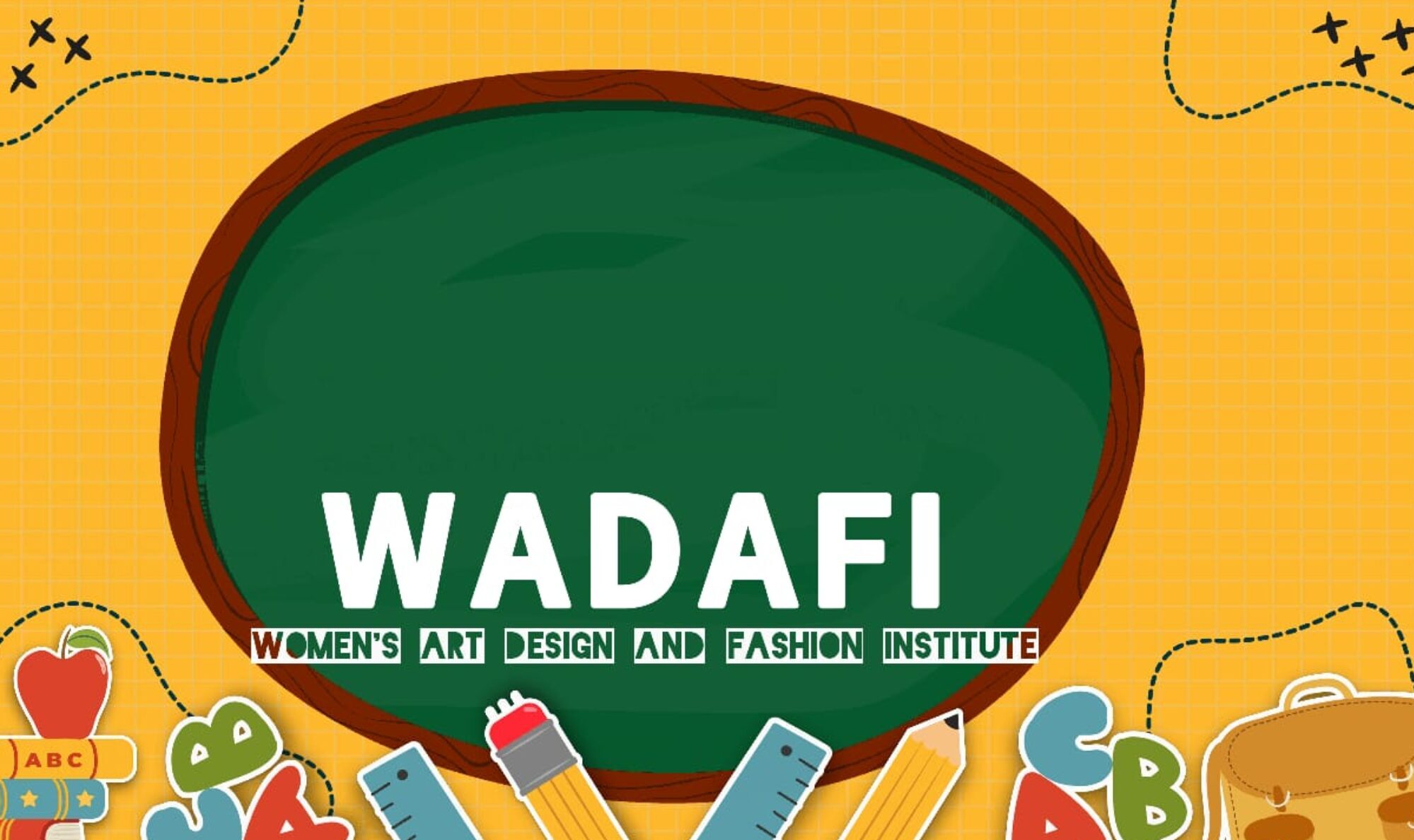Fashion Illustration Course Croquis Poses Portrait Rendering Drawing Draping Shading Garment Fabric

Fashion Illustration Course Croquis Poses Portrait Rendering Drawing Draping Shading Garment Fabric
FASHION ILLUSTRATION
1. FASHION CROQUIS
2. POSE DRAWING
3. PORTRAIT DRAWING
4. GARMENT AND SILHOUTTE STUDY
5. 3 D SHADING
6. SKIN RENDERING
7. FABRIC, PRINT AND ORNAMENTATION RENDERING
8. GUIDE TO FULL ILLUSTRATION
DETAILS
1. BASIC CROQUIS
i) Blocks and Measurements
ii) Proportions and freehand Drawing
2. POSE DRAWING
i) Body Blocks
ii) Head and Body Movements
iii) Hands Movement
iv) Leg Movement
v) Features
vi) Full Figure Drawing
3. PORTRAIT STUDY
i) Facial features
ii) Front / Guidelines
iii) Side / Guidelines
iv) One Third / Guidelines
v) Side / Guidelines
vi) Hair Drawing
4. SILHOUTTE AND FOLDS
i) Lines and Flare details
ii) Folds and Silhoutte
iii) Movement with Folds
iv) Features
v) Draping Garment on Croquis
5. SHADING EXERCISE
i) Shading Exercise
ii) Block Shading
iii) Different Type of Shading
6. FIGURE SHADING
i) Hair Shading
ii) Face Shading
iii) Body Shading
7. GARMENT SHADING
i) Fold Shading
ii) Garment Shading
iii) Texture Shading
8. SKIN RENDERING
i) Alcohol Colour Base
ii) Watercolor Base
iii) Pencil Color Base ( Three Skin Tones )
9. FABRIC RENDERING
i) Cotton
ii) Denim
iii) Silk
iv) Net
v) Fur
vi) Leather
10. ORNAMENTATION RENDERING
i) Beads
ii) Sequince
iii) Embroidery
iv) Applique
11. PRINT RENDERING
i) Floral
ii) Animal
iii) Geometrical
iv) Stripes
v) Checks
vi) Applying Prints on Garments
Fashion Illustration Course Croquis Poses Portrait Rendering Drawing Draping Shading Garment Fabric
Fashion Illustration Course Croquis Poses Portrait Rendering Drawing Draping Shading Garment Fabric
🧾 Detailed Notes for Fashion Illustration Students
✨ 1. Importance of Fashion Illustration in Design
Fashion illustration is not just sketching – it’s a visual language. Designers use it to communicate ideas, silhouettes, fabrics, and embellishments before producing actual garments. Mastering fashion illustration helps students:
Express design concepts clearly
Build professional portfolios
Visualize garment fall, flow, and fit
Understand body proportions and movement
✏️ 2. Understanding Croquis
A croquis is a quick sketch of a fashion figure (typically 9 heads tall).
Used as a base to draw garments and experiment with designs.
Helps maintain proper proportion and symmetry.
Practice Tip:
Use grid sheets and draw croquis in different standing and walking poses to improve line confidence.
🧍♀️ 3. Pose Drawing Techniques
Static Poses: Front, side, and back views (used for showcasing structure).
Dynamic Poses: Movement-based, with balance and gestures (ideal for editorial-style illustration).
Use body blocks and center lines to align the figure.
Key Elements to Study:
Weight distribution
Limb angles and curves
Gesture lines
🎭 4. Portrait and Face Illustration
Study basic head shapes and divide for facial features (eyes, nose, lips).
Practice front, side, and ¾ views.
Focus on expression and hairstyle, which bring emotion and character to fashion sketches.
Student Activity:
Draw 5 different hairstyles on the same portrait to practice detail rendering.
👗 5. Garment & Silhouette Study
Understand types: A-line, straight, flare, mermaid, etc.
Observe how fabric behaves: clings, drapes, flows, or holds structure.
Illustrate with realistic folds and creases.
Style Tip:
Use a croquis to overlay different silhouettes and observe body balance.
🪡 6. Draping & Folds
Draping shows the interaction between fabric and body.
Study fabric weight: Light fabrics (chiffon, net) vs. heavy (denim, velvet).
Types of folds: pipe, zigzag, spiral, drop folds.
Practice:
Draw a single croquis wearing garments in 3 different fabrics to see how drape changes.
🌈 7. Shading Techniques
Flat shading: Adds simple depth
Block shading: Gives strong volume
Gradient shading: For soft transitions in folds and curves
Use pencil, markers, or charcoal based on the fabric and depth you want to show.
🧴 8. Skin Rendering
Choose color mediums:
Alcohol markers (blending effect)
Watercolors (for wash and softness)
Pencil colors (control and layering)
3 Basic Skin Tones to Practice:
Light / Fair
Medium / Wheatish
Deep / Dark
Blend shadows under the chin, nose, and neckline for realistic effects.
🧵 9. Fabric Rendering Techniques
Learn how to illustrate texture, fall, and shine:
Cotton: Matte with crisp folds
Denim: Structured with heavy shading
Silk: Glossy with smooth gradients
Fur: Layered strokes and texture
Net: Use fine mesh texture and transparency
Leather: Use bold lines and high contrast shading
Student Tip:
Cut small fabric swatches and try to recreate the same look on paper.
💎 10. Ornamentation & Print Rendering
Draw details like:
Beads (highlight with white dots)
Sequins (reflective circles)
Embroidery (thread texture with direction)
Appliqué (raised fabric detail)
Print Types:
Floral (organic shapes)
Animal (spots/stripes)
Geometric (squares, zigzags)
Stripes & Checks (symmetry and flow)
Assignment Idea:
Design a kurta or dress and render it with two different types of prints.
📚 Additional Student Activities
Fashion Lookbook Project: Create 5 themed illustrations (bridal, casual, western, etc.)
Color Theory Practice: Use the same garment in three different color palettes
Moodboard Assignment: Make a moodboard and sketch fashion based on it
Fashion Face Challenge: Re-draw 10 faces with different expressions and makeup
Fabric Swatch Practice: Keep a sketchbook of drawn vs. real fabric samples
Fashion Illustration Course Croquis Poses Portrait Rendering Drawing Draping Shading Garment Fabric
🎨 Fashion Illustration Course – From Croquis to Fabric Rendering
Fashion illustration is the heartbeat of the fashion industry. It is where creativity meets technical skill, where design ideas are brought to life on paper before they become reality. Our Fashion Illustration Course is designed to guide you through every essential step – from drawing basic croquis to rendering complex garments, fabrics, and embellishments.
Whether you’re a beginner dreaming of becoming a fashion designer or an advanced student looking to refine your skills, this course covers everything you need.
✍️ What Will You Learn in This Fashion Illustration Course?
1. Fashion Croquis
You will start by learning how to create the basic croquis – the 9-head figure used in fashion drawing. We teach block structure, accurate proportions, and freehand sketching to build a strong foundation.
2. Pose Drawing
Next, you’ll understand how to give your croquis life through dynamic poses. You will learn:
Body block movements
Head, arm, and leg flexibility
Full figure illustration with natural gestures
3. Portrait and Face Drawing
You will explore portrait study in detail. Learn how to draw expressive eyes, noses, lips, and hairstyles. We cover front, side, and three-quarter views with professional guidelines.
4. Garment and Silhouette Drawing
Understanding how a garment fits on a body is essential. This module focuses on:
Silhouettes and fashion lines
Folds and drapes
Draping garments on croquis
Movement and structure in clothing
5. Shading and Texture Rendering
A flat sketch becomes realistic with 3D shading techniques. We cover:
Block shading
Texture shading
Hair, face, and body shading
6. Skin Tone Rendering
You will learn to render realistic skin using:
Alcohol markers
Watercolors
Pencil colors (including 3 basic skin tone palettes)
7. Fabric Rendering Techniques
Master the visual feel of fabrics such as:
Cotton, Denim, Silk, Net, Fur, Leather
Understand how each fabric falls, shines, and folds
Apply textures using pencils, markers, or paints
8. Ornamentation & Print Rendering
To make your designs stand out, you’ll learn how to illustrate:
Embroidery
Sequins
Appliqué
Floral, animal, geometric, striped, and checked prints
Applying prints on full garments
🧑🎓 Who Can Join This Course?
Fashion design students
Artists or illustrators
Boutique owners or stylists
Beginners interested in fashion sketching
Anyone wanting to build a strong portfolio for college or work
💼 Career Opportunities After This Course
After completing this course, you can explore roles such as:
Fashion Illustrator
Portfolio Designer
Freelance Sketch Artist
Textile/Fabric Illustrator
Fashion Concept Artist for Brands
Fashion CAD Assistant (with digital upgrade)
🎓 Why Choose Our Fashion Illustration Course?
Step-by-step structured syllabus
Learn traditional and modern rendering techniques
Real garment-inspired assignments
Certificate upon completion
Practice-based learning with portfolio building
📍 Location-Based SEO Tip (optional add-on for your site):
Join the Best Fashion Illustration Course in Nagpur at WADAFI Institute!
Our fashion institute offers hands-on training, expert mentors, and a complete syllabus to prepare you for the fashion industry.
Fashion Illustration Course Croquis Poses Portrait Rendering Drawing Draping Shading Garment Fabric
📌 Fashion Illustration Course – FAQ
1. What is Fashion Illustration?
Fashion Illustration is the visual representation of fashion concepts through sketches and drawings, showing clothing, accessories, textures, and poses in a creative and technical way.
2. Who can join this Fashion Illustration course?
Anyone with an interest in fashion, drawing, or design can join – from beginners to advanced learners, students, boutique owners, or aspiring designers.
3. Do I need drawing experience to join this course?
No. The course starts from the basics like croquis and body proportions and moves to advanced techniques like fabric rendering and shading.
4. What topics are covered in the course?
You will learn:
Croquis creation
Pose and portrait drawing
Draping and garment sketching
3D shading techniques
Skin tone rendering
Fabric and ornamentation rendering
Print application on garments
5. Will I learn how to sketch real-life garments?
Yes. You’ll learn how to drape garments on croquis and illustrate various silhouettes, folds, and textures realistically.
6. Do you teach shading and coloring techniques?
Yes. The course covers block shading, texture shading, and rendering using alcohol markers, watercolor, and colored pencils.
7. What fabric types will I learn to render?
You’ll learn to render cotton, denim, silk, net, fur, and leather along with realistic textures and shadows.
8. Do you teach how to draw facial features and hairstyles?
Absolutely. We cover portrait drawing, including front, side, and one-third views, along with detailed hair rendering.
9. Will I receive a certificate after completion?
Yes, students who complete all assignments and modules successfully will be awarded a professional certificate.
10. Is this course helpful for fashion design entrance exams or interviews?
Definitely! It enhances your portfolio and builds strong sketching skills – highly valued in fashion colleges and job interviews.
11. Can I use the skills from this course to start freelancing?
Yes. After the course, you’ll be equipped to work as a freelance fashion illustrator or design sketch artist for brands and boutiques.
12. Are live classes or practice sessions included?
Depending on your enrollment plan, both live sessions and guided practice assignments are included.
